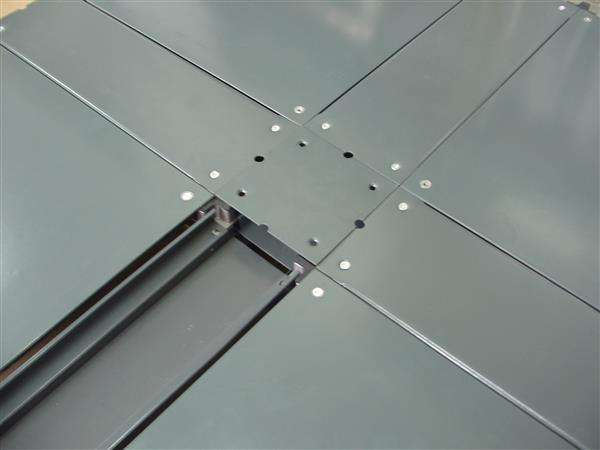NEWS TAG
brand
Raised Floor Industry Production & Testing Standard Introduce - CISCA Recommended Test Procedures For Access Floors
How do you choose the right Access Floor with good quality for your building? What is the industry-approved testing method for Access Flooring products? In this guide, we introduce you to the most authoritative industry production standard and specification of Raised Floor - CISCA Recommended test procedures for access floors, to help you pick up the best access floor manufacturer.

Access Floor Industry Production & Testing Standard - Raised Floor Specification
Raised Floors are assembled with Pedestals, Stringers, and Panels. There is a certain amount of suspended space between the horizontal floor and the raised floor panel. It can be used to make the underfloor wire management and airflow supply in the computer room, data room and equipment room, it is quite practical. Due to its good comprehensive performance, it is increasingly popular in the market. There are many types of raised access floors and suppliers to choose from. You have more choices, and you need to be more educated than ever. How to determine its quality, durability and service life when accepting the access flooring system?

Access Floor Acceptance Criteria:
1. When accepting raised floor, whether it is on the floor surface or on the top of the head, it must be kept clean and at the same time check the surface of the raised floor for obvious damage such as scratches and cracks. In addition, there are strict requirements for the robustness of raised floors. You can try walking on it first, check if it has a strong shake and if it will make a sound.
2. When accepting, please pay attention to whether the edge strips of the floor are on the same line. The misalignment between two adjacent floors should be controlled within 1 mm and the height difference should be less than 1 mm.
All above is only the simple check you can do before acceptance, is there any authoritative certification and testing for access flooring system? The answer is YES!
What is the Industry Approved Test Method/Standard for Raised Access Flooring?
Actually there are different production and testing standards for raised flooring system in different areas around the world, like American CISCA, British MOB, China SJ|/T10796-2001 and more. However, the CISCA (Ceilings & Interior Systems Construction Association) – Recommended Test Procedures for Access Floors Section 6 – Pedestal Overturning Moment Test is recognized as the most authoritative standard for access floor testing.
What is CISCA - Recommended Test Procedures for Access Floors?
The American CISCA “Recommended Test Procedures for Access Floors” represents a significant milestone in establishing a common basis of accepted test methods for access floor, intending to benefit contractors, specifiers, users, and manufacturers. By providing an accepted frame of reference for access floor testing, product characteristics can be judged in a fair context of industry-approved uniform test methods. CISCA’s intent is to provide a method for evaluating access floor characteristics, not criteria requirements. Because differing circumstances demand a range of performance levels, both manufacturers and users benefit from a variety of types of access floors in the marketplace.
In order to obtain the most comprehensive characteristics of the access floor being tested, CISCA “Recommended Test Procedures for Access Floors” provides a full range of test procedures which are user-oriented and represent sound engineering principles, covering from the various access floor accessories to the most important performance criteria of the raised floor.
CISCA "Recommended Test Procedures for Access Floors" Contains:
Concentrated Load Test
Purpose: To determine the maximum deflection(s) and permanent set(s) of an access floor under load.
Performance Requirement: Provide floor panels, capable of withstanding a concentrated design load of 1,250 lbf. (4448 N) with a bottom-surface deflection under load not to exceed 0.080 inch (2.03) and a permanent set not to exceed an average of 0.010 inch (0.25) according to CISCA/AF Section 1, “Concentrated Loads”.
Ultimate Load Test
Purpose: To determine the Maximum load applied onto the panel without failure.
Performance Requirement: Provide access flooring system capable of withstanding a minimum ultimate load of three times the concentrated load without failing, according to CISCA/AF, Section 2, “Ultimate Loading”.
Rolling Loads Test
Purpose: To determine the durability and/or deformation of an access floor system when exposed to commercially anticipated caster traffic using a specific load.
Performance Requirement: Provide access flooring system capable of withstanding rolling loads of the following magnitude, with a combination of local and overall deformation not to exceed 0.040 inch (1.02) mm after exposure to rolling over CISCA/FA Path A or B, whichever path produced the greatest top surface deformation, , according to CISCA/AF, Section 3, “Rolling Loads”.
a. CISCA/AF Wheel 1 Rolling Load: 500 lbf. (2224 N)
b. CISCA/AF Wheel 2 Rolling Load: 500 lbf. (2224 N)
Stringer Load Test
Purpose: To determine the amount of permanent set sustained by stringer when subjected to a concentrated load.
Performance Requirement: Provide stringers, without panels in place, capable of withstanding a concentrated load of 550 lbf (2447 N) at center span with a permanent set not to exceed 0.010 inch (0.25 mm), as determined per CISCA/AF Section 4, Stringer Load Testing”.
Pedestal Axial Load Test
Purpose: To verify the axial load an access floor pedestal assembly can withstand without structural failure or damage to components inclusive of threads, nuts, collars, etc.
Performance Requirement: Provide pedestal assemblies, without panels in place, capable of withstanding a 9,000 lbf (40,034 N) axial load per pedestal, according to CISCA/AF Section 5, “Pedestal Axial Load Test”, without any permanent deformation.
Pedestal Overturning Moment Test
Purpose: To determine the pedestals ability to resist overturning movement and if a lateral load applied to the pedestal
Performance Requirement: Provide pedestal assemblies, without panels in place, capable of withstanding an overturning moment of 1,000 inch-pounds (113 NM) per pedestal, according to CISCA/AF Section 6, “Pedestal Overturning Moment Test”, when glued to a clean, sound, uncoated concrete surface.
Uniform Load Test
Purpose: To determine the maximum deflection(s) and permanent set(s) of an access floor under a uniformly distributed load.
Performance Requirement: Provide access flooring system capable of withstanding a uniform load of 350 lbf/ft2 (16,758 N/M2 ) placed the over area one panel with a permanent set not to exceed 0.010 inch (0.25 mm) after the load is removed, according to CISCA/AF Section 7, “Uniform Load Test”
Drop Impact Load Test
Purpose: To determine the effects and/or deformation of an access floor panel and understructure, when subjected to heavy loads being dropped onto the access floor system.
Performance Requirement: Provide raised flooring system capable of withstanding a drop impact load of 150 lb. (68 kg) dropped from a height of 36 inches (914 mm) without a failure of the system, according to CISCA/AF Section 8, “Drop Impact Load Test”.
Fire Performance Test
Purpose: To determine the class of Fire resistance (Reaction to fire, Flame Spread and Smoke Generation)
Performance Requirement: System shall meet Class A Flame spread requirements for flame spread and smoke development. Tests shall be performed in accordance with ASTM-E84-1998, Standard Test Method for Surface Burning Characteristics for Building Materials.
Air Leakage
Purpose: To determine airtightness specification and the performance on preventing unintentional air leakage from the underfloor cavity into the occupied space.
That’s all the tests are referred to in the CISCA Access Floor Testing standard. Actually any raised floor product can pass the CISCA Recommended test procedures for access floors guarantees excellent performances and long service life!
The raised floor produced in China by HuiYa and provided by AccessFloorStore.Com is strictly in accordance with American CISCA "Recommended test procedures for access floors", British mob "active floor products standard" and China's industry standards, SJ|/T10796-2001 "General specification for anti-static raised floor" production, our quality of raised floor has been approved by the Anti-static Product Quality Supervision and Inspection Center of the Ministry of Information Industry.
